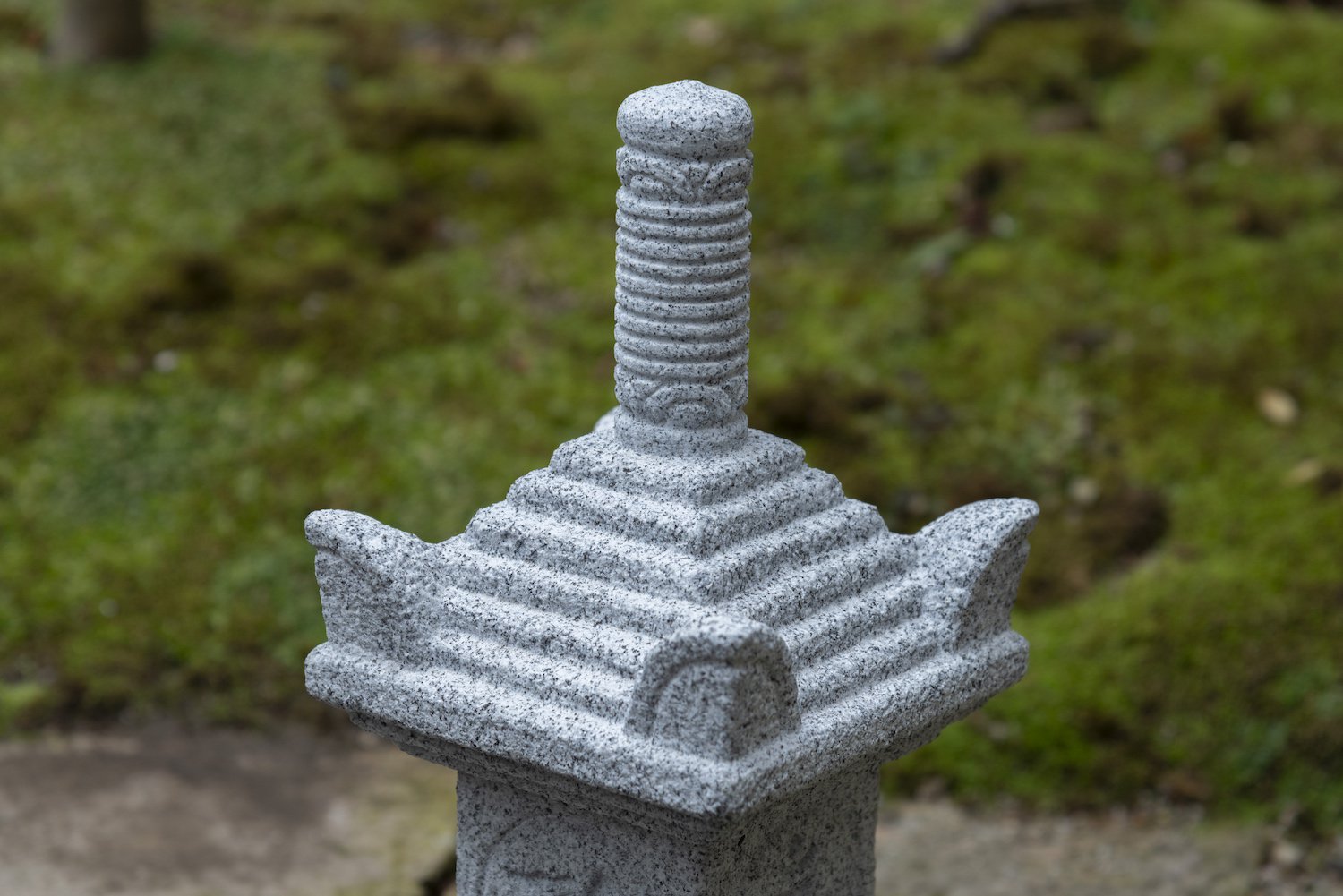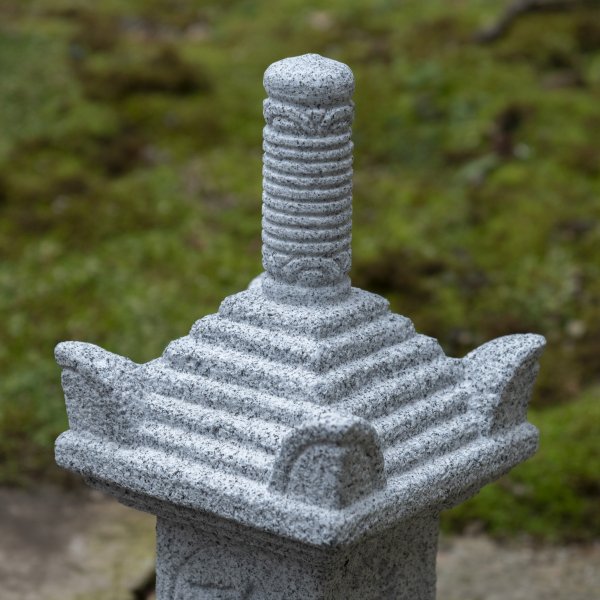���������ξ�������亰����Hokyoin-to pagoda of Makabe Stone
130,000��(�ǹ�143,000��)
English Follows Japanese Below
Ħ���ͥ�줿��븩�������Ф���Ѥ����������ݻΤ���Ħ���������Ƽ���ΰ���ʪ�Ǥ���
�����ʤ����ˤ�������䤹��������������亰��㡣
���ܤ���ɽ�������ФǤ��뿿���Ф��������ȡ��������ݻΤˤ��٤䤫�ʵ��Ѥ�������ʤǤ���
�⤵41�ѤȤ������Ǥ�������䤹����¸�ߴ��Τ��붡����Ǥ���
��亰���ˤĤ���

��亰���ʤۤ����礦����Ȥ��ˤϡ��������������Ȥ��Ʒ��Ƥ���ʩ��ΰ��Ǥ������äʷ��ǡ���Ȥξ�˳��ʾ��γޤȡ��֤Ӥ�Τ褦�ʶ���������Τ���ħ�Ǥ�����������亰��������ʤۤ����礦�������ˡˤȤ������Ф�Ǽ��뤿�����ǡ�������ܤ����褷�ޤ�����
������ȤȤ���Τ���͵������ꡢ����������ץ�ʸ�������Ф��ơ��������ζ�����亰���ϡ���������ʹߤ˵�²������Ƿ��Ƥ��ȸ����Ƥ��ޤ���ʿ�»�������βο͡�������������Ԥ��������ˤ�����亰����㫤��Ƥ��ޤ���
�ߤ����Ф���ɽ�ʡ���븩�������Ф����

�����Фϡ���븩����Կ����϶�Ǻ��Ф�����־��Ǥ������ΰ��ӤϸŤ������ɼ��ʲ�־��λ��ϤȤ����Τ�졢�����ޤǤϡ־�Φ���ߤ����פȸƤФ�Ƥ��ޤ������ֺ�Υ�ܤˤ���Ѥ���Ƥ����к�ǡ������϶���濴�ˡ��ߤ�������ɽ�Ȥ����Τ��Ƥ��ޤ����Ĥߤ��ӤӤ�ͥ�������ܤ���ħ�ǡ���ǯ�ˤ���Ĥߤ����������Ƥ��ޤ����������ˤ����ʤ���⡢�Ȥ��ۤɤ�̣���ФƤ���Τ��������Ф�̥�ϤǤ����ۿ�Ψ���㤯�Ϥ���ޤ�����Ϥ����ɤ������������ܤ�Ĺǯ���ڤ��ߤ��������ޤ���
�������ݻΤˤ���Ħ��ΰ���

Ħ���ܤ����Τϡ���븩�dz������롢�������ݻΡ���ʩ�������Ƥ�Ħ���Ĺ�����ϸ��ο��ͤ�����İ�ļ�Ħ��ǻž夲�ޤ����������Фϡ����ֽФ����ӥ����á���Ȥ��ä����ᤫ�ʤ��ù����������������̥�Ϥ��Ǥ�ȸ����Ƥ��ޤ����������Ħ���ʤ�٤䤫�ʥӥ�����ܤ�������������ʤɤ�Ĵ�¤��䤹�������������˻ž夲�Ƥ��ޤ�����
���ʾܺ�
��갷����Τ�����
���ʤ�������� | Buy The Product
Ħ���ͥ�줿��븩�������Ф���Ѥ����������ݻΤ���Ħ���������Ƽ���ΰ���ʪ�Ǥ���
�����ʤ����ˤ�������䤹��������������亰��㡣
���ܤ���ɽ�������ФǤ��뿿���Ф��������ȡ��������ݻΤˤ��٤䤫�ʵ��Ѥ�������ʤǤ���
�⤵41�ѤȤ������Ǥ�������䤹����¸�ߴ��Τ��붡����Ǥ���
��亰���ˤĤ���

��亰���ʤۤ����礦����Ȥ��ˤϡ��������������Ȥ��Ʒ��Ƥ���ʩ��ΰ��Ǥ������äʷ��ǡ���Ȥξ�˳��ʾ��γޤȡ��֤Ӥ�Τ褦�ʶ���������Τ���ħ�Ǥ�����������亰��������ʤۤ����礦�������ˡˤȤ������Ф�Ǽ��뤿�����ǡ�������ܤ����褷�ޤ�����
������ȤȤ���Τ���͵������ꡢ����������ץ�ʸ�������Ф��ơ��������ζ�����亰���ϡ���������ʹߤ˵�²������Ƿ��Ƥ��ȸ����Ƥ��ޤ���ʿ�»�������βο͡�������������Ԥ��������ˤ�����亰����㫤��Ƥ��ޤ���
�ߤ����Ф���ɽ�ʡ���븩�������Ф����

�����Фϡ���븩����Կ����϶�Ǻ��Ф�����־��Ǥ������ΰ��ӤϸŤ������ɼ��ʲ�־��λ��ϤȤ����Τ�졢�����ޤǤϡ־�Φ���ߤ����פȸƤФ�Ƥ��ޤ������ֺ�Υ�ܤˤ���Ѥ���Ƥ����к�ǡ������϶���濴�ˡ��ߤ�������ɽ�Ȥ����Τ��Ƥ��ޤ����Ĥߤ��ӤӤ�ͥ�������ܤ���ħ�ǡ���ǯ�ˤ���Ĥߤ����������Ƥ��ޤ����������ˤ����ʤ���⡢�Ȥ��ۤɤ�̣���ФƤ���Τ��������Ф�̥�ϤǤ����ۿ�Ψ���㤯�Ϥ���ޤ�����Ϥ����ɤ������������ܤ�Ĺǯ���ڤ��ߤ��������ޤ���
�������ݻΤˤ���Ħ��ΰ���

Ħ���ܤ����Τϡ���븩�dz������롢�������ݻΡ���ʩ�������Ƥ�Ħ���Ĺ�����ϸ��ο��ͤ�����İ�ļ�Ħ��ǻž夲�ޤ����������Фϡ����ֽФ����ӥ����á���Ȥ��ä����ᤫ�ʤ��ù����������������̥�Ϥ��Ǥ�ȸ����Ƥ��ޤ����������Ħ���ʤ�٤䤫�ʥӥ�����ܤ�������������ʤɤ�Ĵ�¤��䤹�������������˻ž夲�Ƥ��ޤ�����
���ʾܺ�
- �Ǻࡧ��븩��������
- ���������⤵41�ѡ���16�ѡ�����16��
- �Ť���12kg
��갷����Τ�����
- ���ξ��ʤϡ��������к�ǽ���Ƥ��ꡢ��Ħ��κ��ʤǤ������Τ��ᡢ��İ�Ĥο�̣��ɽ���ۤʤꡢ�ޤ����֤��Ѳ��ˤ�äƿ��礤���Ѳ����ޤ���
- �����Ǥ⤴���Ѥ��������ޤ���
- ��������κݤϡ�����ڤä����ݥ���餫���ۤʤɤǡ��褴�����Ȥ��Ƥ���������
- ľ�������ʤ�Ĺ���֤θ��ξȼͤˤ�äơ������Ѳ�����ʤ��ǽ��������ޤ���
- Material: Ibaraki Prefecture's Makabe
- Size: Height 41 cm, Width 16 cm, Depth 16 cm
- Weight: 12 kg
- This product is made of natural stone and hand-carved, resulting in variations in color and expression. The color may change over time due to natural aging.
- Suitable for both indoor and outdoor use.
- For cleaning, use a damp sponge or soft cloth to remove dirt.
- Prolonged exposure to direct sunlight may accelerate color changes.
Using high-quality Makabe stone from Ibaraki Prefecture, this sculpture is hand-carved by local stonemasons. Each piece is a one-of-a-kind handmade creation.
A small Hokyointo pagoda that can easily be incorporated into a small garden. This exquisite piece showcases the beauty of Makabe stone, a granite that represents Japan, and the intricate craftsmanship of traditional artisans. Standing at a height of 41 cm, it is a memorial tower that is easy to incorporate into your home while maintaining a commanding presence.
About Hokyoin-to pagoda
The Hokyointo pagoda is a type of Buddhist tower erected as a memorial or grave marker. It is characterized by its unique shape, featuring a stepped umbrella and petal-like corner decorations on top of the main body. Originally designed to house the Hokyoin Dharani sutra, this type of pagoda was introduced to Japan from China.
Along with the Gorinto pagoda, it has been popular since ancient times. While the Gorinto pagoda is known for its simple design, the more ornate Hokyointo pagoda became favored by the nobility from the mid-Kamakura period onwards. Notably, Izumi Shikibu, a poet from the mid-Heian period, is enshrined in a Hokyointo pagoda at Seishin-in in Kyoto.
Using the Representative Ibaraki Stone, Domestically Produced Granite
Makabe stone is granite quarried in the Makabe district of Sakurai City, Ibaraki Prefecture. This area has long been known as a source of high-quality granite, and was known as "Hitachi Ko Mikage" until the Meiji period. It is the stone material used in Akasaka Imperial Villa, and is known as a representative of domestically produced Mikage, especially in the Kanto region. It is characterized by a gentle bluish color that deepens with age. The appeal of Makabe stone is that it is resistant to weathering, but develops a unique character the more it is used. Although it does not absorb water easily, it has good drainage and the beautiful stone grain can be enjoyed for many years.
An Exquisite Hand-Carved Piece by Traditional Craftsmen
The carving was done by traditional craftsmen active in Ibaraki Prefecture. Local artisans skilled in carving stone Buddhas and stone lanterns meticulously finished each piece by hand. Makabe stone is said to best reveal its natural charm through processes such as cobbling, bishan, and small pounding, rather than polishing. These carvings also feature delicate bishan, giving them a natural stone-like finish that harmonizes well with Japanese-style gardens.
Product Details
Handling Instructions





